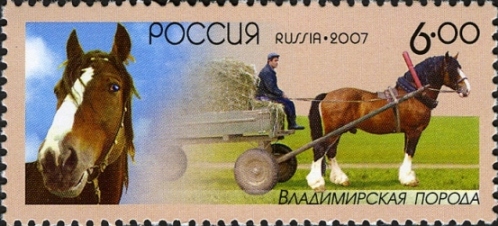The Vladimir Heavy Draught Horse

significantly influenced by the Clydesdale. During the early years of the twentieth century, stallions of various
heavy breeds were imported into Russia from Britain and France. They were crossed with the local mares of the
region to try to produce a good, heavy workhorse.
Some of the most influential stallions were the Clydesdales Lord James, Border Brand and Glen Albin. Shire
stallions were also used, as well as some Cleveland Bays, Suffolks, Ardennais horses and Percherons. The experiment
was successful, producing a powerfully built draught horse that was well suited to heavy agricultural and draught
work. The breed was named the Vladimir Heavy Draught Horse and became a breed in 1946.
The Vladimir Heavy Draught Horses docile nature makes it easy to handle and its active paces which many claim it
inherited from the Clydesdale mean that it can be used to pull the famous Russian troikas. Another bonus is that
it matures very early. By the age of three, the horse is so well developed by the age of three it can start work
and be used in breeding.
The stallions are credited with a very high fertility rate. However, it isnt all sweetness and light. These horses
can sometimes have rather long backs and flat-sided ribcages. A long back is not conductive
of strength and flat-sided ribcages makes the horse unable to get as much air into its lungs as a horse with a
well-sprung ribcage.
The Vladimir Heavy Draught Horse is the biggest of all the Russian heavy breeds. Stallions can have girths of at
least six feet and weigh in at 758kgs. Mares are only a bit smaller with girths of six feet, five inches and a
weight of 675kgs. Stallions reach 16.1 hands and mares will get to 15.3 hands. They come in the colours of bay,
black and chestnut.